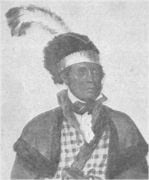Creek Tribe
Creek Indians. A confederacy forming the largest division of the Muskhogean family. They received their name form the English on account of the numerous streams in their country. Where did the Creek Indian tribe live? During early historic times the Creek occupied the greater portion of Alabama and Georgia, residing chiefly on Coosa and Tallapoosa rivers, the two largest tributaries of the Alabama river and on the Flint and Chattahoochee Rivers. They claimed the territory on the east from the Savannah to St. Johns river and all the islands, thence to Apalachee Bay, and from this line northward to the … Read more


